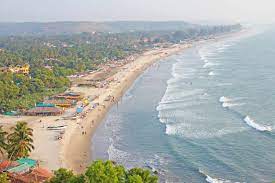Gujarat is located in the western part of India, experiences a diverse climate due to its vast geographical expanse and varying topography. The climate of Gujarat can be broadly categorized into three main seasons: summer, monsoon, and winter.

Summer (March to June)
-
- Summers in Gujarat are hot and dry, with temperatures often soaring above 40°C (104°F) in many regions.
- Coastal areas, such as cities like Ahmedabad and Surat, tend to be slightly cooler due to the moderating influence of the Arabian Sea.
- Inland regions and the northern parts of Gujarat, such as Kutch and Rajkot, experience higher temperatures during the peak summer months.
Monsoon (July to September)
-
- The southwest monsoon brings much-needed rainfall to Gujarat during the monsoon season.
- Coastal Gujarat, particularly areas like Valsad and Navsari, receive higher amounts of rainfall compared to the Saurashtra region and Kutch in the northwest, which experience relatively lower rainfall.
- The monsoon is essential for agriculture in the state and contributes to the replenishment of rivers, reservoirs, and groundwater.
Winter (October to February)
-
- Winters in Gujarat are mild and pleasant, with temperatures ranging from 10°C to 25°C (50°F to 77°F).
- Coastal areas have milder winters compared to the northern regions, which experience cooler nights.
- The winter season is a popular time for tourists to visit Gujarat, as the weather is comfortable for outdoor activities and sightseeing.
Gujarat’s climate is influenced by several factors
- Arabian Sea: The presence of the Arabian Sea to the west of Gujarat influences the climate, particularly in coastal areas. The sea breeze helps moderate temperatures and adds moisture to the air, affecting humidity levels.
- Rann of Kutch: The vast Rann of Kutch in the northwestern part of the state has a unique climate. It experiences extreme temperatures during both summer and winter due to its low-lying and arid terrain.
- Gir Forest: The Gir Forest in southern Gujarat is home to the Asiatic lion and experiences a tropical savanna climate, similar to the adjoining Saurashtra region.
- Topography: Gujarat’s topography varies from plains to hills, affecting local weather patterns and temperature variations.
Gujarat’s diverse climate supports a range of agricultural activities, including the cultivation of cotton, groundnuts, and fruits. The state’s weather is also suitable for various industries, making Gujarat an economically vibrant region in India.
According to the Koppen climate classification scheme, Gujarat’s climate is primarily classified as a combination of two main climate types: Tropical Wet and Dry Climate (Aw) and Tropical Savanna Climate (Aw/As).
Tropical Wet and Dry Climate (Aw):
-
- This climate type is predominant in the coastal areas of Gujarat, including cities like Surat and Valsad.
- The Aw climate is characterized by distinct wet and dry seasons and high temperatures throughout the year.
- Summers (March to June) are hot and dry, with temperatures often soaring above 40°C (104°F) in many regions.
- The monsoon season (July to September) brings significant rainfall to the coastal areas, providing relief from the summer heat. Coastal Gujarat receives a considerable amount of precipitation during this period.
- Winters (October to February) are relatively mild and dry, with temperatures ranging from 10°C to 25°C (50°F to 77°F).
Tropical Savanna Climate (Aw/As):
-
- This climate type is found in the northern and central parts of Gujarat, including regions like Ahmedabad and Rajkot.
- The Aw/As climate shares characteristics of both Aw and As climates. It has hot and dry summers similar to the Aw climate and relatively higher temperatures compared to coastal areas.
- Summers in this region can be extremely hot, with temperatures often exceeding 40°C (104°F) and sometimes reaching up to 45°C (113°F) or more.
- The monsoon season brings some rainfall to these areas, but it is generally lower compared to the coastal regions.
- Winters are relatively cooler than summers, with temperatures ranging from 10°C to 25°C (50°F to 77°F) during the day.
Gujarat’s climate is influenced by its geographical location and topography. The Arabian Sea to the west of the state moderates temperatures along the coastal areas, making them relatively cooler during summers. The Rann of Kutch in the northwestern part of Gujarat experiences a unique climate due to its low-lying and arid terrain.
Overall, Gujarat’s climate is characterized by hot and dry summers, a monsoon season with varying amounts of rainfall across the state, and relatively mild winters. The state’s diverse climate supports various agricultural activities, industries, and tourism, making Gujarat an economically significant region in India.
Overall, Gujarat’s climate, with its hot and dry summers, monsoon-driven rainfall, and mild winters, provides a conducive environment for both agriculture and tourism, contributing to the state’s overall development and prosperity.